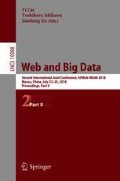Abstract
User locations in social networks are needed in many applications which utilize location information to recommend local news and places of interest to users, as well as detect and alert emergencies around users. However, considering individual privacy, only a small portion users share their location on social networks. Thus, to predict the fine-grained locations of user tweets, we present a joint model containing three sub models: content-based model, social relationship based model and behavior habit based model. In the content-based model, we filter out those location-independent tweets and use deep learning algorithm to mine the relationship between semantics and locations. User trajectory similarity measure is used to build a social graph for users, and historical check-ins is used to provide users’ daily activity habits. We conduct experiments using tweets collected from Shanghai during one year. The result shows that our joint model perform well, especially the content-based model. We find that our approach improves accuracy compared to the state-of-the-art location prediction algorithm.
Access this chapter
Tax calculation will be finalised at checkout
Purchases are for personal use only
References
Chandra, S., Khan, L., Muhaya, F.B.: Estimating Twitter user location using social interactions-a content based approach. In: IEEE Third International Conference on Privacy, Security, Risk and Trust, pp. 838–843 (2012)
Cheng, Z., Caverlee, J., Lee, K.: You are where you tweet: a content-based approach to geo-locating Twitter users, vol. 19, no. 4, pp. 759–768 (2010)
Crandall, D.J., Backstrom, L., Huttenlocher, D., Kleinberg, J.: Mapping the world’s photos. In: International Conference on World Wide Web, pp. 761–770 (2009)
Ichiye, T., Karplus, M.: Collective motions in proteins: a covariance analysis of atomic fluctuations in molecular dynamics and normal mode simulations. Proteins Struct. Funct. Bioinf. 11(3), 205 (1991)
Kearney, J.K., Hansen, S.: Stream editing for animation (1990)
Kim,Y.: Convolutional neural networks for sentence classification. CoRR, abs/1408.5882 (2014)
Kim, Y., Chiu, Y., Hanaki, K., Hegde, D., Petrov, S.: Temporal analysis of language through neural language models. CoRR, abs/1405.3515 (2014)
Kong, L., Liu, Z., Huang, Y.: SPOT: locating social media users based on social network context. VLDB Endow. 7, 1681–1684 (2014)
Lee, K., Ganti, R.K., Srivatsa, M., Liu, L.: When Twitter meets foursquare: tweet location prediction using foursquare. In: International Conference on Mobile and Ubiquitous Systems: Computing, Networking and Services, pp. 198–207 (2014)
Lin, S.K., Sheng-Zhi, L.I., Qiao, J.Z., Yang, D.: Markov location prediction based on user mobile behavior similarity clustering. J. Northeast. Univ. (2016)
Backstrom, L., Sun, E., Marlow, C.: Find me if you can: improving geographical prediction with social and spatial proximity. In: International Conference on World Wide Web, pp. 61–70 (2010)
Gasparini, M.: Markov chain Monte Carlo in practice. Technometrics 39(3), 338 (1997)
Robinson, M.: The temporal development of collision cascades in the binary collision approximation. Nucl. Inst. Methods Phys. Res. B 48(1–4), 408–413 (1990)
Sadilek, A., Kautz, H., Bigham, J. P.: Finding your friends and following them to where you are. In: ACM International Conference on Web Search and Data Mining, pp. 723–732 (2012)
Serdyukov, P., Murdock, V., Zwol, R.V.: Placing flickr photos on a map, pp. 484–491 (2009)
Xu, D., Yang, S.: Location prediction in social media based on contents and graphs. In: International Conference on Communication Systems Network Technologies, pp. 1177–1181 (2014)
Author information
Authors and Affiliations
Corresponding author
Editor information
Editors and Affiliations
Rights and permissions
Copyright information
© 2018 Springer International Publishing AG, part of Springer Nature
About this paper
Cite this paper
Liu, R., Cong, G., Zheng, B., Zheng, K., Su, H. (2018). Location Prediction in Social Networks. In: Cai, Y., Ishikawa, Y., Xu, J. (eds) Web and Big Data. APWeb-WAIM 2018. Lecture Notes in Computer Science(), vol 10988. Springer, Cham. https://doi.org/10.1007/978-3-319-96893-3_12
Download citation
DOI: https://doi.org/10.1007/978-3-319-96893-3_12
Published:
Publisher Name: Springer, Cham
Print ISBN: 978-3-319-96892-6
Online ISBN: 978-3-319-96893-3
eBook Packages: Computer ScienceComputer Science (R0)

